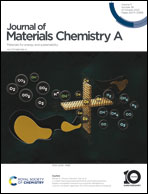Composition and temperature influence on hydrogenation performance of TiZrHfMoxNb2–x high entropy alloys†
Abstract
High entropy alloy (HEA) is a composition tuneable alloy with a relatively simple crystal structure, making it convenient to regulate its hydrogenation performance as hydrogen storage material. In this study, the influences of temperature (RT, 300–600 °C) and partial elemental substitution on the hydrogenation performance of body-centred cubic (BCC) single-phase TiZrHfMoxNb2–x (x = 0, 1, 2) HEAs were thoroughly investigated. Results show that a smaller valence electron concentration (VEC) is the preferable parameter to enhance the kinetic storage capacity with other external factors (particle size, initial hydrogen pressure, activation parameters, cycle times, and mass) kept constant, even though the atomic size mismatch (δ) becomes smaller. It is demonstrated that the hydrogen absorption kinetic mechanisms at low and high temperatures are in accordance with the hydrogen atoms diffusion controlled geometrical contraction model and metal atom diffusion-controlled nucleation-growth-impingement model, respectively. Specifically, the increased hydrogenation temperature provides an external driving force for the phase transformation of HEAs from BCC to face-centered cubic (FCC) and facilitates the occurrence of such displaced phase transformation. The neighbor diffusion of metal atoms gradually becomes the rate-limiting step with the increasing hydrogenation temperature. Moreover, the increasing substitution of Mo facilitates the migration of atomic hydrogen in the lattice and accelerates the phase transformation of hydrogenation, as the hydrogen affinity of Mo is lower than that of Nb. In summary, achieving the correlation between hydrogenation performance to temperature and composition can facilitate a more in-depth understanding of displacive phase transformation in HEAs for hydrogen storage.

- This article is part of the themed collection: #MyFirstJMCA


 Please wait while we load your content...
Please wait while we load your content...